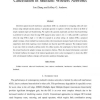Free Online Productivity Tools
i2Speak
i2Symbol
i2OCR
iTex2Img
iWeb2Print
iWeb2Shot
i2Type
iPdf2Split
iPdf2Merge
i2Bopomofo
i2Arabic
i2Style
i2Image
i2PDF
iLatex2Rtf
Sci2ools
JSAC
2010
2010
Adaptive Spatial Intercell Interference Cancellation in Multicell Wireless Networks
Downlink spatial intercell interference cancellation (ICIC) is considered for mitigating other-cell interference using multiple transmit antennas. A principle question we explore is whether it is better to do ICIC or simply standard single-cell beamforming. We explore this question analytically and show that beamforming is preferred for all users when the edge SNR (signal-to-noise ratio) is low (< 0 dB), and ICIC is preferred when the edge SNR is high (> 10 dB), for example in an urban setting. At medium SNR, a proposed adaptive strategy, where multiple base stations jointly select transmission strategies based on the user location, outperforms both while requiring a lower feedback rate than the pure ICIC approach. The employed metric is sum rate, which is normally a dubious metric for cellular systems, but surprisingly we show that even with this reward function the adaptive strategy also improves fairness. When the channel information is provided by limited feedback, the impac...
| Added | 19 May 2011 |
| Updated | 19 May 2011 |
| Type | Journal |
| Year | 2010 |
| Where | JSAC |
| Authors | Jun Zhang, Jeffrey G. Andrews |
Comments (0)

